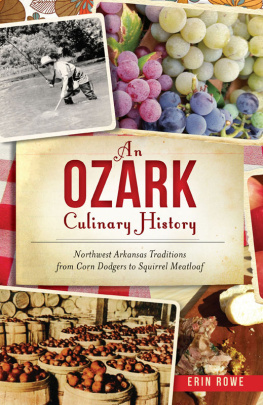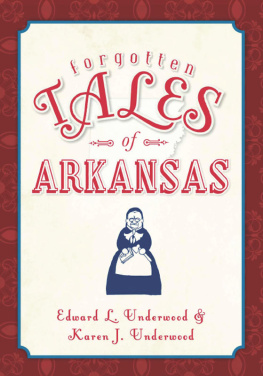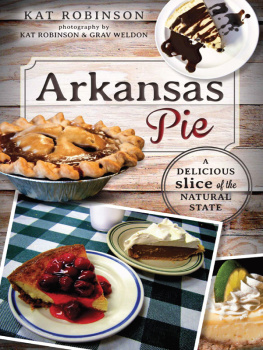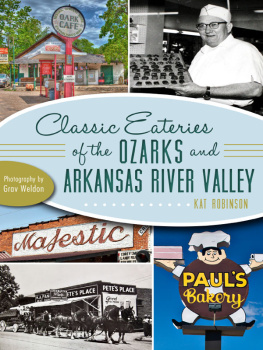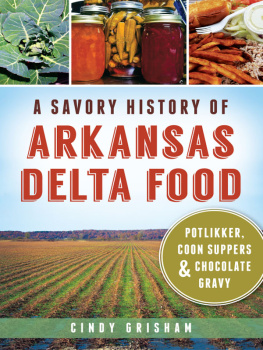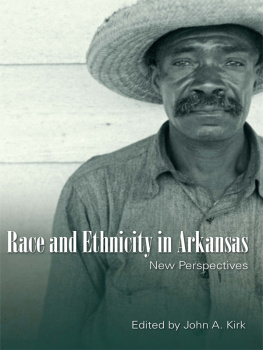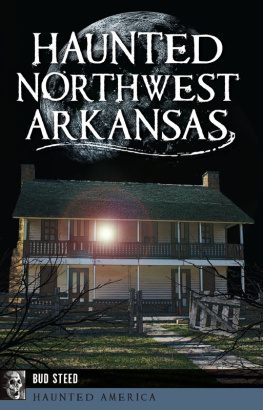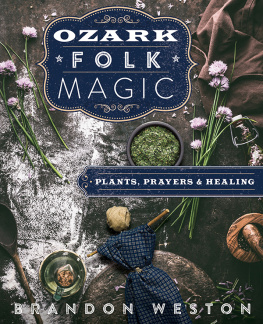

Published by American Palate
A Division of The History Press
Charleston, SC
www.historypress.net
Copyright 2017 by Erin Rowe
All rights reserved
Front cover, top right: River fishing in waders is the best way to catch Ozark trout. Rogers Historical Museum;
First published 2017
e-book edition 2017
ISBN 978.1.43966.249.6
Library of Congress Control Number: 2017940941
print edition ISBN 978.1.46713.608.2
Notice: The information in this book is true and complete to the best of our knowledge. It is offered without guarantee on the part of the author or The History Press. The author and The History Press disclaim all liability in connection with the use of this book.
All rights reserved. No part of this book may be reproduced or transmitted in any form whatsoever without prior written permission from the publisher except in the case of brief quotations embodied in critical articles and reviews.
Lord, you establish peace for us; all that we have accomplished you have done for us.
Isaiah 26:12
This book is dedicated to the Lord who blessed me with a loving husband, Alex, to champion my dreams; friends and family to support and help me; and this whole opportunity to write in the first place.
FOREWORD
It is so exciting to be herecelebrating our farmers and delicious, locally grown food.
I think theres a temptation to view gathering out here on this beautiful farm with a sense of nostalgia. But I would like to argue that what we are doing is actually something very new.
Were all here as the restless descendants of immigrants. We are the people who have been defined by leaving, people who believed in new opportunity someplace else and moved on. You might say this has become an American tradition: stay until the land is exploited, then move on.
So what were doing is new. We are choosing to stay and figure out what staying will look likeslowing down, adapting, listening. Every week at the farmers market is an exploration of what it means to farm well and eat well in this specific place, to choose to farm and eat in ways that move past just sustainability, that actually leave the land healthier and more diverse for future generations. Our palates and fields will be informed by the flavors and traditions of newer waves of immigration from Asia and Latin America. There will be new discoveries and heirloom varieties rediscovered.
This is slow, healing work that will take many lifetimes to realize. It is impossible to say where those conversations will take us. But because this is a revolution based not on maximized production, but on taste and on intimate connections between growers and eaters and the land, I am confident in saying this: the future will be delicious.
We celebrate our role in this hopeful new future. Cheers to you, friends, and to the years of good eating to come!
from Casey Letelliers toast at the 2015 Siloam Springs
Farm to Table Dinner at R Family Farm
Chef and restaurant owner Miles James acknowledges, I think any book being written on our region is great.
To me, cooking is the ultimate art form. When it all comes togetherthe sounds of searing meats and popping wine corks hover like mist in the valleyits quite a rush.
Chef Miles James, from his latest book, Cuisine of the Creative
CHAPTER 1
OZARK BEGINNINGS
Northwest Arkansas begins in the Ozark Mountains. These rugged mountains are set apart from the rest of the Natural State, just like the rugged people who first called it home. Northwest Arkansas early settlers lived in isolation for many years, carving out a plot to grow food in an unreachable and densely forested land.
Geographically, this region is known for its extensive forests of hickory, oak and pine, as well as highly abundant water resources, including swift streams, rivers and reservoirs. Here, surface rocks are older than those exposed outside the region, including dolomite and limestone, many of which house fossils from a time when the mountains were the guardians of an ancient inland sea, per author Harry S. Ashmore in Arkansas: A History. Geological evidence shows strata from these seas overlying the Ozarks from various periods of the Paleozoic era. With the close of this era, seas receded, and over time, erosion took its toll on the mountains, rounding them off to the Ozarks. The first Arkansas hillbillies, or hill folk, found them a veritable never-never land of uncharted territory.
The decay of these rock formations left behind rich sediments of limestone, dolomite, shale, loess and alluvial deposits, creating a diverse Ozark soil. This soil could grow corn, a staple crop for man and his animals during early settlement days. Limited early crop cultivation in mountain valleys was supplemented by the many rewards of the Ozark forests: wild game, fish and the gathering of wild greens, nuts, fruit and honey, according to the Encyclopedia of Arkansas. Even the forests abundance of hardwoods was an immediate resource for log houses, which could be built in just a few days by not having to haul wood long distances. Ozark settlers could return home with the wild turkey, deer or squirrel theyd just hunted instead of waiting on resources to build a home or the growing season to eat a meal.
Over time, these mountain settlers learned to produce more of their daily needs, due to their isolation from other towns and transportation sources. Living in a primarily subsistence economy, nearly all pioneer families of the Ozarks grew whatever wheat, tobacco, flax, hemp and cotton they could for domestic use.
Natural wildlife in the Ozarks was so abundant that families could subsist on game alone if they so desired. For example, abundant wild hogs called hazel splitters or razorbacks roamed the woods freely, becoming a primary staple meat in the diet of early settlers due to its ability to be preserved. Other game such as squirrel, raccoon, rabbit and possum (which might be uncommon to find on a restaurant menu today) were plentiful and at the ready for any Ozark hunters table, per author Milton D. Rafferty. One Madison County resident even said of the possum, We put it in the pot and biled it; and then put it on and baked it. Thats just one recommendation. Heres another one: Possums! I should say so. Dey cotch plenty of em and after dey was kilt Ma would scald em and rub em in hot ashes and dat cleant em just as pretty and white. Oo-oo-oo but dey was good. Lord Yessum.
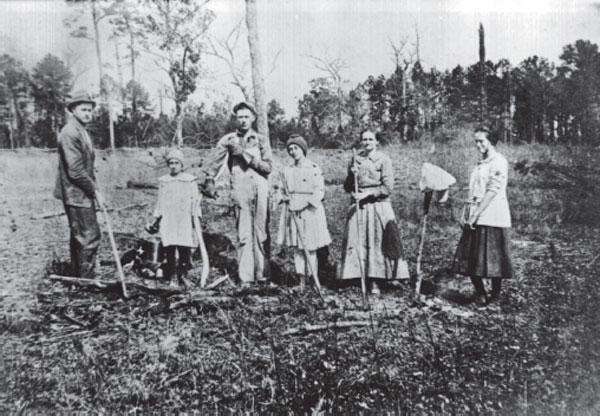
A typical Ozark family with field-clearing tools. Rogers Historical Museum.
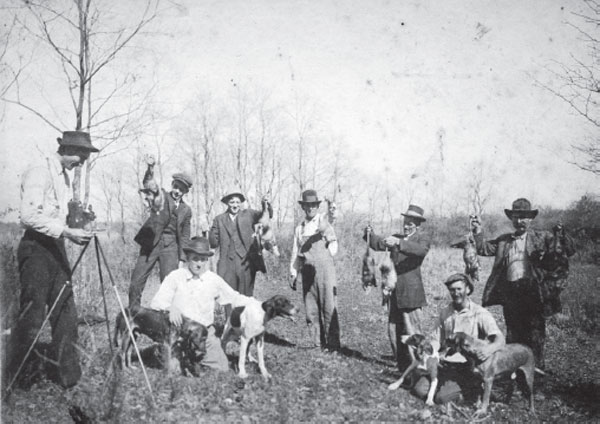
The great possum hunt in the Ozarks drew in two photographers to document its success. Siloam Springs Museum.
The rugged people of the Ozarks learned to work with what the land would give them, from its ample supply of wild game and forest fruits to what they could cultivate themselves in its rocky soil. The temperate climate ensured much could grow in its longer spring and summers than the neighboring territories to the north. Infrequent snows and killing frosts in late October and November also extended the growing season. People of the Ozarks largely relied on their own industriousness, as no major roads reached these parts, per Rafferty. For instance, in the Boston Mountains area of the Ozarks (south of modern-day Fayetteville), mountain gorges 500 to 1,400 feet deep were not uncommon for settlers to negotiate. Navigating the Ozark forests on foot or animal was difficult for any but the hardiest and most determined.
Next page
